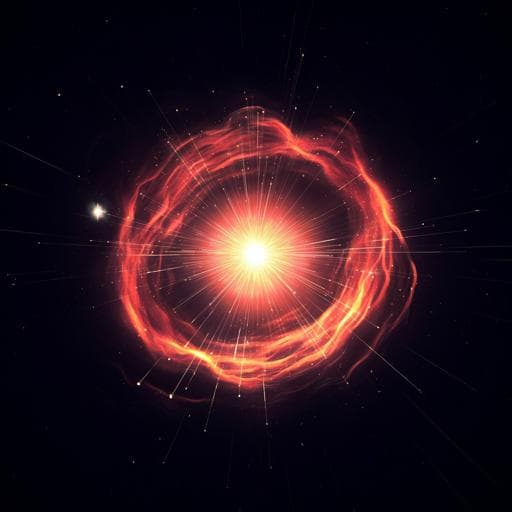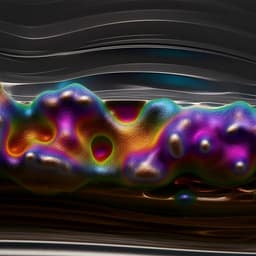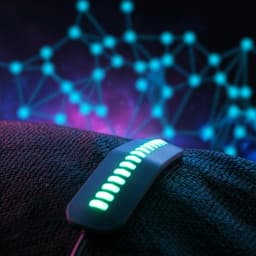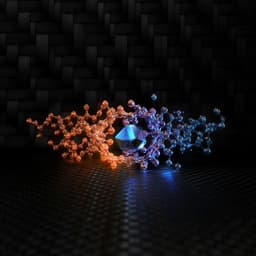
Physics
Dipolar skyrmions and antiskyrmions of arbitrary topological charge at room temperature
M. Hassan, S. Koraltan, et al.
This groundbreaking research, conducted by Mariam Hassan and colleagues, reveals the direct observation of dipolar skyrmions and antiskyrmions in Co/Ni multilayers at room temperature, pushing the boundaries of spintronics. The study delves into topological charges, their energy dependencies, and stability factors, showcasing exciting potential for device applications through micromagnetic simulations.
~3 min • Beginner • English
Introduction
Topological magnetic textures with particle-like properties can be characterized by an integer topological charge Q, conferring topological protection. Skyrmions in chiral magnets are typically stabilized by short-range interactions such as the Dzyaloshinskii–Moriya interaction and are most often observed with Q = −1, with higher-Q states (bags/bundles) realized only rarely and usually at cryogenic temperatures. An alternative stabilization mechanism relies on competition between long-range dipolar and short-range exchange interactions in thin films with perpendicular magnetic anisotropy. Dipolar-stabilized skyrmions and antiskyrmions can be realized in sputtered multilayers at room temperature with tunable properties via layer engineering, offering scalability advantages. Prior dipolar systems have shown coexistence of Q = −1 skyrmions, Q = 0 type-II bubbles, and Q = +1 antiskyrmions, and rare Q = +2 antiskyrmions. The research question addressed here is whether small dipolar-stabilized skyrmions and antiskyrmions with arbitrary (including high) topological charges can be realized and controlled at room temperature in industrially friendly multilayers, and how their nucleation, energetics, stability, and current-driven dynamics behave.
Literature Review
Two main stabilization routes are established: (1) chiral magnets with Dzyaloshinskii–Moriya interaction (DMI), which commonly host Q = −1 skyrmions (e.g., FeGe, Heuslers) and, in few cases, skyrmion bags/bundles of arbitrary charge; (2) dipolar-exchange competition in perpendicularly magnetized thin films, where dipole skyrmions and lattices have been reported (e.g., Fe–Gd). Higher-order antiskyrmions (e.g., Q = +2) have been observed in ferrimagnetic multilayers, resembling multiple iterations of Bloch and Néel segments, akin to domain walls with vertical Bloch lines (VBLs) long studied in bubble materials. However, earlier bubble systems typically displayed larger, irregular domains. The Co/Ni multilayer platform offers room-temperature stability, accessibility via sputtering, and tunability of saturation magnetization and anisotropy to reach regimes where high-order (anti)skyrmions may coexist.
Methodology
Experimental: A series of [Co(0.2 nm)/Ni(0.7 nm)]_n multilayers with n = 4–11 were dc magnetron sputtered at room temperature on oxidized Si(100) and 30-nm Si3N4 membranes, with Pt(3 nm) seed and Si3N4(3 nm) cap. Magnetic characterization used SQUID-VSM to obtain M–H loops in out-of-plane (OOP) and in-plane (IP) orientations at room temperature, yielding saturation magnetization Ms ≈ 1,000 kA m−1 and perpendicular anisotropy. Ferromagnetic resonance (VNA-FMR) with OOP fields provided Ku via Kittel fits using measured Ms. Lorentz TEM (JEOL NEOARM-200F, 200 keV, Fresnel mode, ~2 mm underfocus) imaged magnetic domain morphology; magnetic induction maps were reconstructed via transport-of-intensity equation from defocused image series.
Micromagnetic simulations: Conducted with magnum.np (GPU-accelerated finite-difference), solving LLG with exchange, demagnetization, uniaxial anisotropy, and external field energies. Typical grids: 5,000 × 5,000 × 1 cells at 1 × 1 × t nm^3 discretization (t = film thickness). For n=5 (t = 4.5 nm): Ms = 940 kA m−1, Ku = 575 kJ m−3, Aex = 10 pJ m−1. For n=10 (t = 9 nm): Ms = 1,000 kA m−1, Ku = 675 kJ m−3, Aex = 10 pJ m−1. Initialization used random magnetization at zero field; OOP field ramped by 1 mT/ns to saturation; magnetization states, simulated LTEM, and induction maps were computed. High-order (anti)skyrmions were isolated and relaxed in smaller 300 × 300 × 1 boxes with parameter sweeps over Ms and Ku (Aex fixed) to map stability at 30 mT. Validation performed with Mumax3 and Excalibur via energy minimization, showing quantitative agreement.
Current-driven dynamics: A 4,096 × 1,024 × 5 nm^3 strip discretized at 2 × 2 × 5 nm^3 simulated the spin-transfer torque (Zhang–Li model) driven motion of Q = ±1 and ±5 objects with α = 0.1, non-adiabaticity ζ = 0.05, and b = 72.17 × 10^−12. A constant current density |je| = 2 × 10^11 A m−2 with OOP bias field 25 mT was applied for up to 100 ns; trajectories and Hall angles were quantified. SK Hall angle θ_H versus Q was also computed for |Q| up to 15 with pulse length 25 ns and varying current densities.
Topological charge evaluation used contour integration of the azimuthal angle along the soliton boundary; total charge in simulations was also checked via area integral and contour separation.
Key Findings
- Direct experimental observation (LTEM) and simulation of dipolar-stabilized skyrmions (SKs, Q < 0) and antiskyrmions (ASKs, Q > 0) with topological charges up to |Q| = 10 at room temperature in Co/Ni multilayers.
- Objects are enclosed by a single domain boundary containing multiple Bloch and Néel segments; presence and arrangement of vertical Bloch lines (VBLs) in domain walls are crucial for nucleation of higher-order (A)SKs.
- Sizes: Diameters typically 200–500 nm, increasing gradually with |Q|; ASKs tend to maintain circular symmetry, elongating slightly with increasing Q; high-order SKs (Q ≤ −2) occur as circular or elongated (chain-like) configurations.
- Energetics: Self-energy relative to the ferromagnetic state peaks at a characteristic field; at a fixed field (e.g., 15 mT) the (A)SK energy increases nearly linearly with |Q|. Energies of SKs and ASKs with the same |Q| are nearly identical, with differences diminishing as |Q| increases.
- Coexistence: Large-scale simulations and LTEM show simultaneous presence of many (A)SKs with diverse Q, including up to |Q| = 10. Some complex textures could not be uniquely classified by LTEM contrast alone.
- Field evolution: Increasing OOP field shrinks domains and leaves isolated (A)SKs; higher-order objects disappear earlier with increasing field, while Q = −1 SKs are most stable. Simulations show collapse pathways where high-order SKs decay to lower odd Q and eventually to Q = −1 as field increases. Experimentally, transformations such as Q = +4 ASK collapsing to Q = −1 SK are observed.
- Nucleation: High-order (A)SKs nucleate from domain walls decorated with multiple VBLs that shrink and detach under increasing field; the final Q correlates with the number and arrangement of VBLs and involved walls.
- Stability phase diagram: Simulations at 30 mT mapping Ms and Ku identify a phase pocket enabling coexistence of high-order SKs and ASKs when the magnetic quality factor Ku/Ka (Ka ≈ 0.5 μ0 Ms^2) is near unity, roughly within 0.9–1.3, aligning with experimental Ms ≈ 1,000 kA m−1 and Ku ≈ 650–750 kJ m−3.
- Current-driven dynamics: Under je = 2 × 10^11 A m−2 and 25 mT OOP bias, (A)SKs translate and rotate into steady trajectories; higher-order objects reach steady state faster. The skyrmion Hall angle θ_H is largest for |Q| = 1 and decreases strongly with increasing |Q| for both SKs and ASKs; higher current densities further reduce θ_H. This indicates high-order textures mitigate the skyrmion Hall effect.
- Practical platform: Sputtered Co/Ni multilayers allow room-temperature, tunable stabilization of arbitrary-charge (A)SKs with submicron sizes, suitable for device-relevant studies.
Discussion
The study demonstrates that room-temperature, dipolar-stabilized skyrmions and antiskyrmions with arbitrary and high topological charges can be realized in sputtered Co/Ni multilayers. By elucidating nucleation via VBL-rich domain walls and mapping stability versus Ms and Ku, the work clarifies material conditions and field protocols to achieve coexisting high-order textures. The nearly linear energy scaling with |Q| and similar energies of SKs and ASKs at the same |Q|, together with the observed coexistence and collapse pathways, address how topology and dipolar interactions shape stability and transformations, distinct from DMI-driven chiral systems. The current-driven dynamics reveal a significant reduction of the skyrmion Hall effect with increasing |Q|, offering a strategy to improve trajectory control in devices like racetrack memories and unconventional computing hardware. The ability to engineer and operate a large set of distinct, interacting nonlinear spin objects in the same film suggests opportunities in reservoir computing and multistate storage. Overall, the findings provide both fundamental insights into high-order dipolar solitons and practical guidance for leveraging them in skyrmionics.
Conclusion
This work provides the first direct observation of high-order dipolar skyrmions and antiskyrmions with topological charges up to 10 at room temperature in Co/Ni multilayers. It establishes their nucleation from VBL-containing domain walls, quantifies energetic trends with topological charge, maps stability conditions near Ku/Ka ≈ 1, and demonstrates reduced skyrmion Hall angles for higher-order textures under spin-transfer torque. The accessible sputtered multilayer platform enables coexistence and control of multiple topological states, promising advantages for skyrmionic devices and unconventional computing. Future research should develop detailed theoretical models for energetics and transformation pathways of high-order (anti)skyrmions, refine imaging and classification methods for complex textures, explore thermal effects and defect landscapes on stability and dynamics, and realize experimental current-driven manipulation in device geometries.
Limitations
Classification of complex spin objects based solely on LTEM contrast is sometimes ambiguous, leaving some textures unassigned. Samples with low repetition numbers (n = 4–5) showed weak LTEM contrast, limiting analysis. Simulations require very fine lateral discretization (<2 nm) to resolve VBLs; coarser meshes destabilize higher-order states. Thermal fluctuations were not included explicitly and material parameters were treated as effective, potentially impacting quantitative stability ranges. While experiments indicated very high |Q| states (e.g., Q = −9 observed during field evolution), some such states could not be stabilized in simulations under tested conditions.
Related Publications
Explore these studies to deepen your understanding of the subject.







